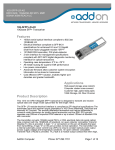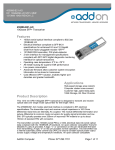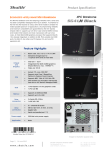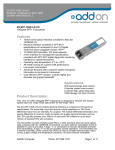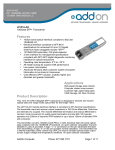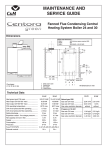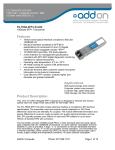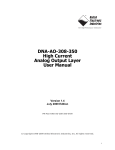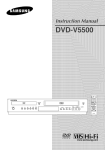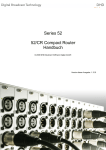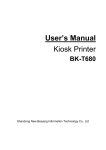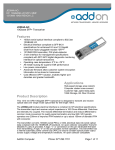Download User Manual
Transcript
Mini 6SI User Manual -1- Contents · Introduction 4 5) Password 21 · Technical specifications 4 6) System Information 22 · Splicer description & Part name 6 · Appendix I 24 · How to the replace the fiber folder 7 · Appendix II 26 · Cleaning 7 · Appendix III 29 · Splice Program - Stabilize Electrodes 8 - Arc Calibration 8 - Splice Menu 1) Splice Mode 9 2) Splice Option 10 3) Heater Mode 11 4) Data Storage 12 5) Menu Lock 13 - Maintenance - Setting 1) System Setting 18 2) Language 19 3) Power Save Option 20 4) Set Calendar 21 Important FIberFox highly recommends all users to read this manual before operating Mini 6S. This manual is valid for the following software version. -2- -3- Introduction exquisite manufacturing technology gives customers unexperienced convenience. Unprecedented splicing experience and new technology greatly reduces splicing and heating time. Advanced estimate method and core alignment technique ensure the accuracy of splice loss estimation. Its small size, compact design and reliable protection shell make it suitable for any operating environment. Dynamic operation interface and automatic splice mod give the customers Standard : 20, 25, 30, 35, 40, 60mm Applicable Sleeve Thanks for choosing Mini 6S FTTx Master from FiberFox. The Mini 6S with innovative design and Heating Oven grat convenience. For more information, please contact your local distributor or visit our website at Custom : 4*32mm sleeve (For SOC) Heating Time 8~900sec (Typical: 18Sec) Cooling Time 0~ 180sec Heat mode www.fiberfox.co.kr Heating block This manual explains the features, specifications, operation, maintenance and warnings about Mini 6S. The primary goal of this manual is to make the user as familiar with the splicer as possiblse. Applicable Fiber Technical specifications High precision dual camera Display 4.3” wide color reinforced LCD Applicable Cable x150 : X&Y axis dual view Microscope 9ea Standard 1ea(Pre-installed) SOC Customized 1ea(In Package) Fiber count : Single core Fiber Type : SM(ITU-TG.652)/ DS(ITU-TG.653)/ NZDS(ITU-TG.655)/ ITU-TG.657 / MM(ITU-TG.651) Splicer Applicable diameter : 0.25mm / 0.9mm / 2.0mm / 2.4mm / 3.0mm Applicable buffer Diameter : Cladding diameter : 80~150µm, Coating diameter : 100~3,000 µm MM : 0.01dB Splice Loss AC 100~240V DS : 0.04dB NZDS : 0.04dB 50~60HZ G.657 : 0.02dB DC9~14V Li-ion Battery DC 11.1V Splice Mode Factory pre-set 33ea User Edit 34ea Data Storage (Splicing result) Splice Speed User Edit SM : 0.02dB x300 : X axis single view x300 : Y axis single view Data Capacity 9ea Fiber count : Single core fber in cable Camera Power Supply Factory pre-set Reliability 3,000ea SM FAST mode 7 Sec. SM AUTO mode 9 Sec. -4- Operating Condition Storage Condition Altitude 0~5,000M Humidity 0~95% Temperature -15~60℃ Wind Speed 15m/s Humidity 0~95% Temperature -5- Splicer -40~80℃ Battery -20~30℃ Splicer description & part name How to replace the fiber holder Heat Oven ON/OFF button 1) Unscrew the bolt 2) Take out the worn holder 3) Replace it by new one 4) Tighten up the screw Caution 1) The unscrewd bolts remains in the holder (Do not take the bolts out) 2) Do not screw down the holder too tight Return Button Cleaning Loop V-Grooves Power Supply / Battery Checking with fiber after cleaning with cotton swab Display Lens Mirrors Caution Serial Port 1) Do not disturb the electrode tips 2) Use only 99% or better purity alcohol Connenctor for Charging Battery -6- -7- Splice Programs [Splice Menu] 1) Splice Mode Splice Menu, Maintenance, Stabilize Electrodes, Setting, User Instruction, Arc Calibration [Stabilize Electrodes] In the event of sudden change in environmental conditions or after cleaning electrodes, the arc power sometimes becomes unstable, resulting in higher splice loss. Especially when the splicer is moved from lower altitudes to higher , it takes time for the arc power to stabilize. In this case, stabilizing electrodes will expedite the process to set the arc power stable. If many tests are needed to get the “Test ok” message appears in [Arc calibration], use this function as well. [Arc Calibration] Atmospheric conditions such as temperature, humidity, and pressure are constantly changing, which creates variability in the arc temperature. This splicer is equipped with temperature and pressure sensors that are used in a constant feedback monitoring control system to regulate the arc power at a constant level. However, changes in arc power due to electrode wear and glass adhesion cannot be corrected automatically. Also, the center position of arc discharge sometimes shifts to the left or to the right. In this case, the fiber splicing position has to be shifted in relation to the arc discharge center. It is necessary to perform an arc power calibration to eliminate those problems. Note : Performing [Arc calibration] function changes the arc power “Factor” value. The factor value is used in the algorithm program for all splicing. The arc power value will not change in the splice modes. -8- Select Splice Mode Factory Pre-set : 33ea Edit Splice Mode User edit : 33ea Custom build splice mode : 1ea Delete Splice Mode -9- 2) Splice Option Auto Start Pause 1 Pause 2 Realign After Pause 2 Ignore Splicing Error Fiber Image On Screen 3) Heater Mode ON : Automatic splicing procedure OFF : Maunal Splicing procedure ON : Pause after the fiber gap position process Select Heater Mode Factory Pre-set : 9ea Edit Heater Mode User edit : 9ea Custom build splice mode : 1ea Delete Heater Mode - OFF : Proceeding without the pause ON : Pause after camera focus & Axis alignment process OFF : Proceeding without the pause ON : Automatically proceed realignment OFF : Proceeding without the pause ‘splicng error’ message is not displayed Select display structure for each splicing process - 10 - - 11 - 4) Data Storage 5) Menu Lock Input password to access the sub-menus Display Splice Record Displaying your detailed splice record Delete Splice Record - Export Splice Data Downloading saved data (Splice record or Image) Splice Data Save ON : Automatic data save * Image data is saved manually * Splice Mode Lock Heater Mode Lock OFF : Do not save splice record Recordes Delete Lock Password Lock - 12 - ON : Disable ‘Splice mode’ edit OFF : Ensable ‘Splice mode’ edit ON : Disable ‘Heater mode’ edit OFF : Enable ‘Heater mode’ edit ON : Disable ‘Record mode’ edit OFF : Enable ‘Heater mode’ edit ON : Disable to change the password OFF : Enable to change the password - 13 - [Maintenance] ▶ Diagnostic Test 1) Maintenance Menu LED Calibration ▶ Quick Optimize Quick & Easy overall maintenance Automatic process ‘Lens focus+motor calibration+fiber training’ ▶ Focus Adjust Find the optimized posion for ‘Press, Focus & Align Motor’ ▶ Replace Electrodes Instruction on how to replace electrodes FiberFox recommendation It is highly recommended to change the electrodes every 3,000 splicing ▶ Motor Calibration Automatically calibrates the speed of all six motors - 14 - Dust Check Motor Calibration Arc Calibration Measures and adjusts the brightness of LED Dust checking process Automatically calibrates the motor speed Automatically calibrates the Arc power ▶ LED Calibration Measures and adjusts the brightness of LED ▶ Dust Check Detect dust&contaminant causing improper splicing In order to find out optimized position for splicing, the splicer analyses the fiber images being transmitted by the optical camera & LED inside but dust or contaminant on the camera, lenses, LED may cause improper splicing result. Therefore, the dust check process is recommended to proceed in case of frequent splicing fail or high insertion loss. - 15 - ▶ Fiber Training ▶ Motor Drive It checks the operation status of 6 motors (L, R Press, X, Y Focus, X, Y Align). ▶ Update Software Upgrade to the latest version. Procedure 1 Prepare the USB device. 2 Download the latest version software to the USB. 3 Link to the Splicer (Via link cable in the package). 4 Press “O’ Button to proceed update. 5 Device will be rebooted once it is done. Automatic Fiber recognition program ▶ Electrode Setting Electrode Caution Caution alram will be displayed when it reachs the number of splicing cycle you set Electrode Warning Caution alram will be displayed when it reachs the number of splicing cycle you set - 16 - - 17 - [Setting] 2) Language Set your own language. 1) System Setting Buzzer ON : Sound on OFF : Sound off Temperature Unit ℃ : Celcisius ℉ : Fahrenheit Automatic Heating ON : Auto start OFF : Manual start Monitor Position Front : Normal direction display Rear : Opposite direction display Dust Check ON : Check the dust density OFF : Skip dust checking process Password Lock ON : Password is required to operate the device OFF : No passwerd is required Pull Test ON : Automatic pull test processing after splicing OFF : Skip pull test process - 18 - Language Available 繁体中文 Việt English العربية 한글 Español Русский Italiano Deutsch Português Français فارسی ไทย - 19 - 3) Power Save Option Monitor Shut Down 4) Set Calendar 1) No input during the time you set, the splicer will block the power supply toward LCD 2) System will be switched over to standby mode. 5) Password Change your password. Press the power button to resume (Screen will be back on) Splicer Shut Down No input during the time you set, the splicer will be shut down to save the power Pressing the power cutton for 2sec, to reboot the splicer Procedure - 20 - 1 Input 4-digit old password number 2 Input new 4-digit number for new password - 21 - 6) System Information Machine Serial No. Software Version FPGA Total Arc Count Identification number of the splicer Software version being installed Field programmable gate array’ version Total number of Arc discharges Current Arc Count Current number of Arc discharge Last Maintenance Last maintenance date Production Date Manufacturing date Sales Region Authorised country for sales Product OEM Manufacturer name - 22 - - 23 - Appendix I Fat Fiber stuffing too much Decrease [Overlap] and perform [Motor clibration] Arc power not adequate Perform [Arc calibration] Some arc parameters not adequate Adjust [Prefuse power], [Pre-fuse time] or [Overlap] Some arc parameters not adequate Adjust [Prefuse power], [Pre-fuse time] or [Overlap] Splice loss increase : Reason and solution. Symptom Name Core Axial Offset Core Angle Core Step Core Curve MFD Mismatch Combution Bubbles Separation Reason Solution Dust on v-groove or fiber clamp chip Clean v-groove and fiber clamp chip Dust on v-groove or fiber clamp chip Clean v-groove and fiber clamp chip Bad fiber end-face quality Check if fiber cleaver is well conditioned Dust on v-groove of fiber clamp chip Clean v-groove and fiber clamp chip Bad fiber end-face quality Check if fiber cleaver is well conditioned Pre-fuse power too low or pre-fuse time too short INcrease [Pre-fuse power] and/or [Pre-fuse time] Arc power too low Increase [Arc power] Bad fiber end-face quality Check the cleaver Dust still present after cleaning fiber of cleaning arc Clean fiber throughly or increase [Cleaning arc time] Bad fiber end-face quality Check if fiber cleaver is well conditioned Pre-fuse power too low or pre-fuse time too short Pre-fuse power too low or pre-fuse time too short Fiber stuffing too small Perform [Motor calibration] Pre-fuse power too high of pre-fuse time too long Decrease [Pre-fuse power] and/or [Pre-fuse time] - 24 - Thin Line Note : A vertical line sometimes appears at the splice point when MM fibers, or dissimilar fibers (different diameters) are spliced. This does not affect splice quality, such as splice loss or tensile strength. - 25 - Appendix II If error message is shown as below during the process, Please follow the instruction accordingly. If the problem still remains, please contact us. Error Message L Fiber Place Error R Fiber Place Error Reason Solution Press the “Reset” Button. Reload The fiber end-face is placed on the the fibers, make sure fiber end face between V-groove and the electrode centerline, or beyond it centre position of electrodes Propulsion Motor Overrun The fiber is no set correctly at the bottom of the V-groove, which results in that the fiber offsets beyond motor formation range Press the “Reset” button and then re-position the fiber at the bottom of the V-groove Propulsion Motor Trouble Motor might be damaged Consult your nearest sales agency Failed to Find The Fiber End-face Press the “Reset” button and The fiber is not set correctly at the then re-position the fiber correctly bottom of the V-groove at the bottom of the V-groove No Arc Discharge Motor Overrun Arc Discharge does not occur Confirm the electrodes in proper position; Replace electrodes Press the “Reset” button and The fiber is not set correctly at the then re-position the fiber at the bottom of the V-groove bottom of the V-groove Press the “Reset” button and Cannot Find The fiber is not set correctly at the then re-position the fiber at the the Edge of The bottom of the V-groove bottom of the V-groove Cladding Find Wrong Fiber Edges There’s dust on the fiber suface Re-prepare the fiber; Clean the lens and protector mirror and then redo “Dust Check” Unidentified Type of Fiber Shock occurred to the splicer during the splicing process Execute “Motor Calibration” If the [problem stillexist, please contact the sale agent - 26 - Unidentified Type of Fibers Contact of Fiber End-faces Focus Motor Overrun Fibers Mismatch Large Cleave Angle Large Core Angle Focus Error Shock occurred to the splicer during the splicing process Execute “Motor Clibration” If the [problem still exist, please contact the sale agent Overlap too much Adjust overlap parameter Motor is not calibrated Calibrate and maintain the motor The fiber is misplaced Press the “Reset” vutton and then reposition the fiber correctly There’s dust of dirt on the fiber surface Prepare the fiber again There’s dust of dirt on the fiber surface Execute the [Dust check] after the lenses and LEDs are cleaned The fibers of two sides are different type It may resul tin large splice loss if you continue to splice, Please use the proper splice mode corresponding to the fibers Bad fiber end-face check the condition of the fiber cleaver, if the blade is worn, rotate the blade to a new position or change a new one, and then re-prepare the fibers [Cleave Limit] is set too low Increase the [Cleave limit] to an adequate limit(standard:3.0˚c) [Core angle limit] is set too low Increase the [Core angle limit] to an adequate limit (standard:1.0˚c) Dust of dirt is on the V-groove or hte clamp chip Clean V-groove and clamp chip. Prepare the fibers and re-load them Too large axial offset(>0.4um)w Re-prepare the fibers The motor is not calibrated Execute [Motor clibration] - 27 - Dust Error (fiber core) Fat Fiber Thin Fiber There’s dust or dirt on the fiber surface Prepare the fiber again The lens or LEDs are coated in dust Execute the dust check after cleaning the lenses and LEDs Cleaning Arc time is too short Set the cleaning arc time to be 180ms It is difficult to identify the fiber core by using the method of core alignment to splice It is difficult to identify the fiber core by using MM splice mode to splice Appendix III [Questions and troubleshooting] · Power does not turn off when pressing On / Off button. Press and hold the key until the LED color changes from green to red. · Few splices can be made with a fully charged battery pack · If the power saving function is not enabled, battery power degrades quicker. [System setting] Always enable it to conserve power usage. · If degradation appears (memory effect). of if the battery pack is stored for an extended period of time, complitely discharge it. After discharge completion, recharge the battery pack. · The battery pack has reached the end of its service life. Install a new battery pack. There’s dust or dirt on the fiber surface Prepare the fiber again There’s dust or dirt on the fiber surface Execute the [Dust check] after the lenses and LEDs are cleaned · Error message appears on monitor please refer to appendix II. Increase the cleave angle limit to a decent value (standard value: 3.0˚c) · Clean the V-grooves, fiber clamps, wind protector mirrors, and objective lenses. Cleave angle limit is too low Overlap too much Adjust overlap parameter · The splice loss varies according to the cleave angle, arc conditions and fiber cleanliness. Motor is not calibrated Calibrate and maintain the motor · The monitor suddenly turn off after an extended period of splicer inactivity, if the power Arc power too low Execute [Arc Calibration] The level of pre-discharge is too high Decreased pre-discharge of pre-discharge time · The monitor will turn off after an extended period of splicer inactivity, if the power saving Insufficient overlap Adjust overlap parameter · Identify fibers error in AUTO mode · The battery pack uses chemical reaction. The capacity decreases at low temperature, especially at lower than 0 degree ˚c. · Inconsistent splice loss / High splice loss · Replace the electrodes. · Please refer to Appendix I. · Monitor suddenly turned off saving function is enabled. Press any key to return to the normal state. · Splicer power suddenly turned off without “Low battery’ message. function is enabled. Press ant key to return to the normal state. AUTO mode is applicable for SM, MM, NZ fiber. Errors may occurs while splicing special fibers. · Mismatch between Estimated splice loss and Actual splice loss · The estimated loss is a calculated loss, so it can be used for reference only. · The optical components of the splicer may need to be cleaned. · Fiber protection sleeve does not shrink completely. · Extend the heating time. · Method to cancer heating process. · Press Heat key to srop during heating process. The LED light will go off after pressing. - 28 - - 29 - · Fiber protection sleeve adhered to heating plate after shrinking use a cotton swab or a similar soft tip object to push and remove the sleeve. · Forgot password Please contact the sale agent. · No arc power change after [Arc calibration] An internal factor is calibrated and adjusted for the specific arc power selected. The displayed arc power in each splice mode does not change. · Forgot to lad fibers while execute some specified function that fibers are needed. Return key is invalid. Open the wind protect shield, load prepared fibers in the splicer, and press “Set” to continue or press “Reset” · Upgrading Failure When users use the “New” U-disk to upgrade, the splice may not be able to correctly identify the upgrade file, you need to re-plug the U-disk, and restart the splicer · Check if the upgrade file name and the format are correct. · If you cannot solve the problem, please contact the sale agent. · Other Please refer to the video in user’s CD - 30 - - 31 -





















